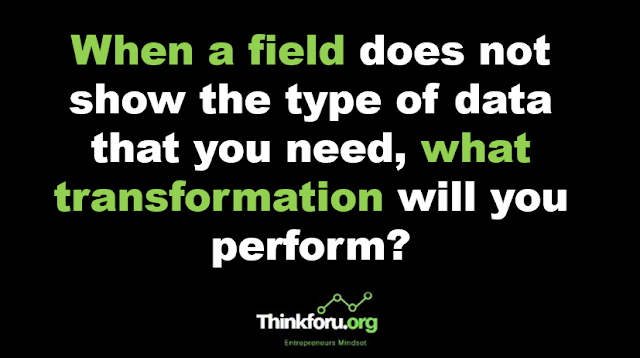When a field does not show the type of data that you need, what transformation will you perform?
 |
| Cover Image of When a field does not show the type of data that you need, What transformation will you perform? |
When a field does not display the type of data required, you may need to perform a data transformation. The specific transformation depends on the nature of the data and the desired outcome. Some common transformations include:
1. Type conversion: Convert the data from one type to another. For example, converting a string representing a number to an actual numeric data type.
2. Parsing: Extracting relevant information from the data. For instance, parsing a date from a string that includes other text.
3. Normalization: Rescaling values to fit within a specific range or format. This is common in machine learning and data analysis.
4. Cleaning: Removing or correcting errors, inconsistencies, or irrelevant information in the data.
5. Aggregation: Combining multiple data points into a single value. This can involve summing, averaging, or finding other statistical measures.
6. Splitting: Dividing a single field into multiple fields or values. For example, splitting a full name field into first name and last name.
7. Joining: Combining multiple fields or values into a single field. This is the opposite of splitting.
8. Filtering: Removing or excluding certain data points based on specified criteria.
9. Imputation: Filling in missing values with estimated or calculated values.
10. Encoding: Converting categorical data into numerical or binary representations suitable for analysis.
11. Standardization: Scaling data to have a mean of 0 and a standard deviation of 1. This is useful for some statistical analyses and machine learning algorithms.
12. Transformation functions: Applying mathematical or statistical functions to the data to achieve the desired result.
13. Feature Engineering: Creating new features from existing data to enhance the predictive power of machine learning models. This can involve combining existing features, creating interaction terms, or generating new features based on domain knowledge.
14. Bucketing/Binning: Grouping continuous data into discrete intervals or bins. This can simplify analysis and visualization, especially for large datasets.
15. Smoothing: Removing noise or variability from data by applying techniques such as moving averages or kernel smoothing.
16. Dimensionality Reduction: Reducing the number of features in a dataset while preserving important information. Techniques like principal component analysis (PCA) or t-distributed stochastic neighbor embedding (t-SNE) can be used for this purpose.
17. Text Preprocessing: Cleaning and transforming text data before analysis. This can involve tokenization, removing stop words, stemming or lemmatization, and converting text to lowercase.
18. Spatial Transformation: Converting spatial data between different coordinate systems or projections.
19. Temporal Transformation: Adjusting temporal data by aggregating into different time intervals (e.g., hourly, daily, monthly) or converting between different date formats.
20. Regularization: Adding penalties to models to prevent overfitting. Techniques like L1 regularization (Lasso) or L2 regularization (Ridge) can be used to shrink coefficients or weights towards zero.
21. Feature Scaling: Scaling features to a similar range to prevent certain features from dominating others in models that rely on distance measures or gradients.
22. Data Augmentation: Generating additional training examples by applying random transformations to existing data. This is commonly used in image processing and natural language processing tasks.
23. Histogram Equalization: Adjusting the contrast of images or other data by redistributing pixel intensities.
24. Principal Angle Transformation: A technique used in multiview learning to transform data from multiple views into a common space by computing principal angles between subspaces.
25. Discretization: Converting continuous variables into categorical variables by dividing them into discrete intervals.
26. Feature Extraction: Deriving new features from existing ones using techniques such as Fourier transforms, wavelet transforms, or signal processing methods.
27. Kernel Methods: Transforming data into a higher-dimensional space using kernel functions to make non-linear relationships easier to model with linear techniques.
28. Anomaly Detection: Identifying and transforming anomalous data points to make them more consistent with the rest of the dataset, or flagging them for further investigation.
29. Dimensionality Expansion: Generating additional features by applying mathematical operations (e.g., polynomial expansion) or combining features to capture more complex relationships.
30. Sampling: Resampling techniques such as downsampling (reducing the number of data points) or upsampling (increasing the number of data points) to address class imbalance or reduce computational complexity.
31. Data Fusion: Integrating information from multiple sources or modalities to create a more comprehensive representation of the data.
32. Outlier Handling: Transforming or removing outliers to improve the robustness of statistical analyses or machine learning models.
33. Bias-Variance Tradeoff: Adjusting model complexity or regularization parameters to balance the tradeoff between bias and variance in predictive models.
34. Batch Normalization: Normalizing input data within each mini-batch to stabilize and accelerate the training of deep neural networks.
35. Gradient Clipping: Limiting the magnitude of gradients during optimization to prevent exploding gradients in deep learning models.
36. One-Hot Encoding: Converting categorical variables into binary vectors with a separate binary variable for each category.
37. Label Encoding: Converting categorical labels into numerical values, often used for target variables in machine learning tasks.
38. Feature Selection: Choosing a subset of relevant features for modeling while discarding irrelevant or redundant ones, based on statistical tests, feature importance scores, or domain knowledge.
39. Data Smoothing: Applying techniques such as moving averages or exponential smoothing to reduce noise and reveal underlying trends in time series data.
40. Time Series Decomposition: Breaking down time series data into its constituent components (trend, seasonality, and noise) for further analysis or modeling.

Post a Comment